Pharmacology of Type II Diabetic Drugs
1/33
There's no tags or description
Looks like no tags are added yet.
Name | Mastery | Learn | Test | Matching | Spaced |
|---|
No study sessions yet.
34 Terms
What is diabetes and what is its main effect?
- A chronic disease wherein the pancreas does not produce enough insulin or
the body cannot effectively use it
- Hyperglycaemia, the main effect of uncontrolled diabetes, can damage
various systems esp nerve and blood vessels
What are the 4 different types of Diabetes
1. Diabetes Mellitus Type I
2. Diabetes Mellitus Type 2
Less common:
3. Gestational Diabetes - occurs during pregnancy
4. Diabetes Insipidus - diabetes due to other causes
What is type I?
Beta-cell destruction and insulin deficiency
- dependent on insulin
What is type II?
Beta cell dysfunction and insulin resistance
- not dependent on insulin
How does GLP-1 work?
When food is ingested outline the 2 pathways it triggers ? hint. GLP 1 in the intestine release is one of them
-After the consumption of food and digestion is
initiated, glucose levels start to increase and
hormones such as GLP-1 (an incretin - a hormone that helps regulate insulin and glucose levels in the body) which is released in
the intestines
- released in intestines
- triggers insulin (insulin acts to decrease
glucose levels)
- inhibits glucagon
- induces feeling of satiety
- reduce appetite
Note: 2nd pathway
- Food consumption also triggers release of pancreatic hormones like insulin,
amylin and glucagon
- Insulin and amylin work to decrease glucose levels and inhibit glucagon while
glucagon acts on the liver to raise glucose levels
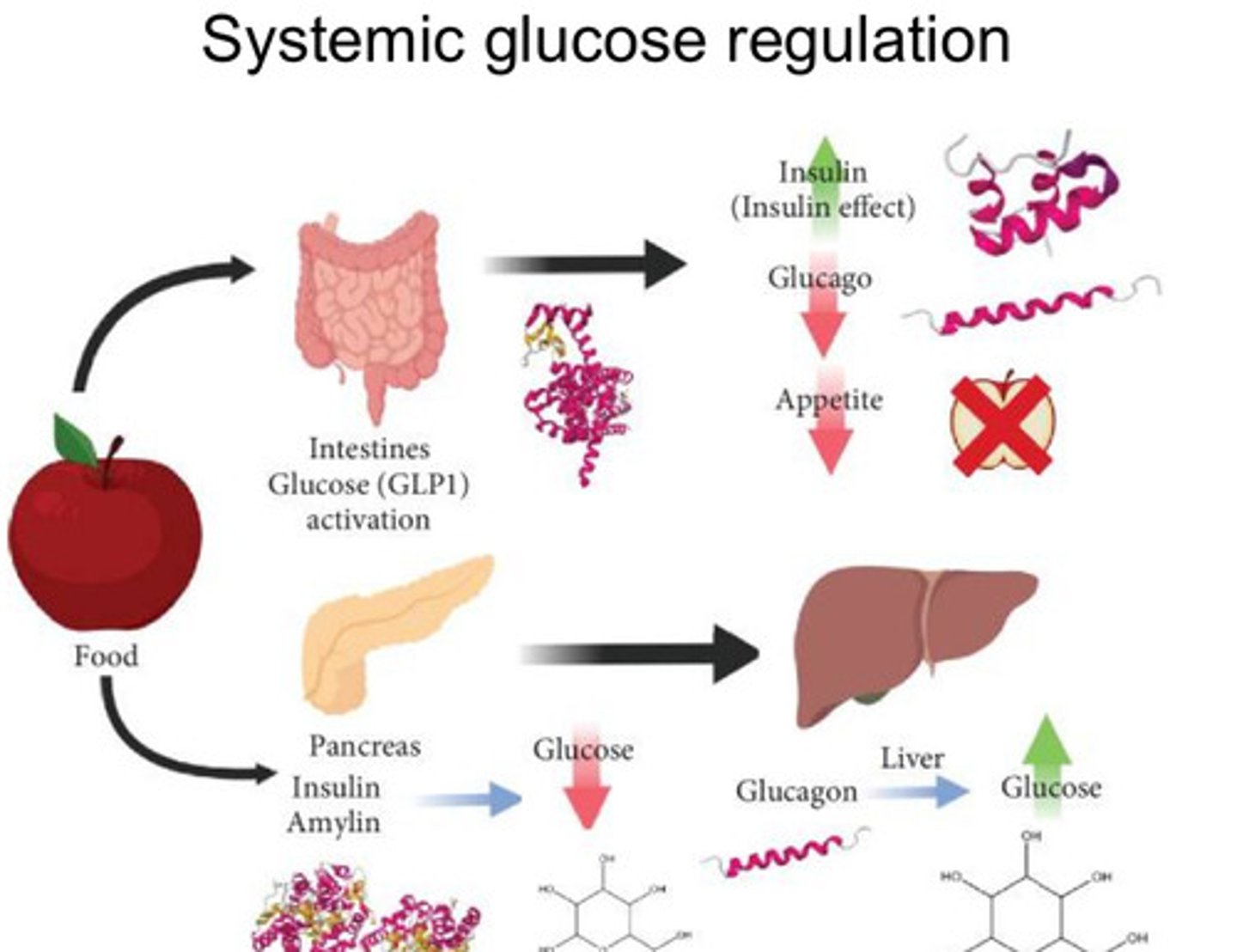
How does glucagon work?
Acts on liver to raise glucose
Outline the goal of Diabetes management, diet suggestions and main treatments for Type I and Type II Diabetes
- Goal of management: keep blood glucose levels as close to normal as safely
possible
- Diet: decrease carbohydrate intake
- Type I: insulin (IDDM)
- Type II: Biguanides, Incretins, DPP4, SGLT2I, amylin analogues, insulin
What is the main agent for type I?
Insulin
What are the main agents for type II?
Biguanides
Incretins
DPP4-I
SGLT2-I
Amylin analogues
What is the main biguanide? How does it work?
- Metformin
- Absorbed from small intestine- half-life is 3 hours, unbound to plasma protein
and excreted unchanged in the urine
It decreased blood glucose concentration by:
- inhibit genes involved in gluconeogenesis in liver
- enhances insulin action on muscle and adipose
- stimulate glycolysis and uptake in tissue
- Decreases carbohydrate absorption
Generally as a drug combinations: given with incretins, DPP4 inhibitors,
SGLT2 inhibitors, sulphonylureas, thiazolidinediones and/or insulin
Why is Metformin preferred?
It does not cause:
- hypoglycaemia
- stimulate appetite
-Cause weight gain
- It reduces microvascular complications
What are Metformin SEs?
diarrhoea, nausea, metallic taste, reduced folate and B12 absorption (may need to take
supplements)
What is a complication of metformin?
Lactic acidosis (rare)
Which anti-type II drugs cause hypoglycaemia?
Sulphonylureas
Thioazolidiones
Insulin
What is the mechanism of action of Metformin?
- Does NOT directly affect insulin, glucagon, GH, cortisol, somatostatin
- Activates AMP-activated protein
kinase (AMPK) which inhibits anabolic gluconeogenesis and promotes catabolic lipid oxidation which prevents insulin resistance
- AMPK activation enhances insulin sensitivity
- Increases intestinal GLP-1 release which enhances glucose induced insulin secretion and glucagon inhibition
- Main way it is thought to act is inhibiting complex-1 in mitochondria which
alters ATP-ADP ratio = activation of AMPK
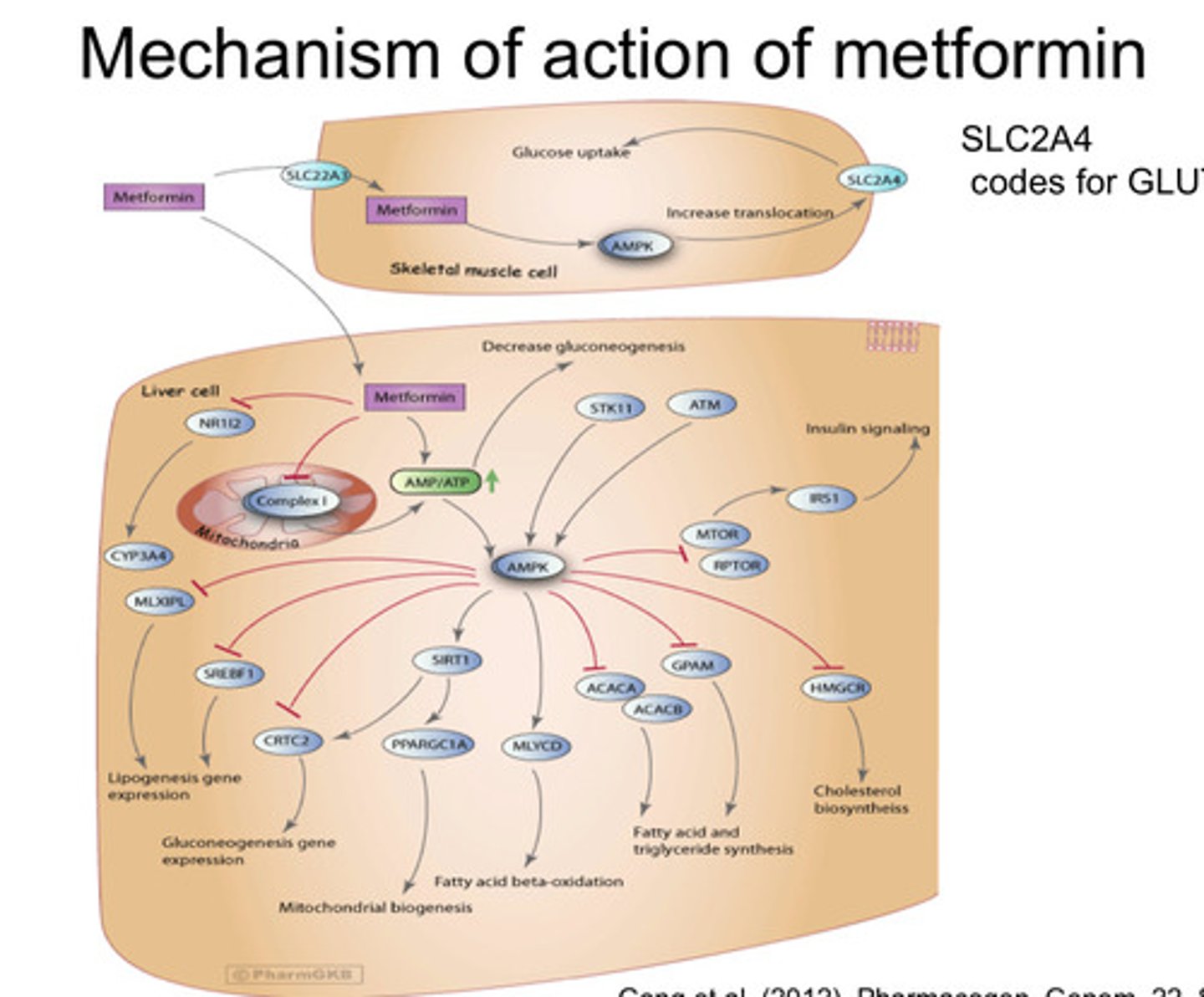
What formulation of insulin causes more insulin release tabs or IV and why?
- Oral glucose causes more insulin release compared to IV due to orally drug goes quickly through the gut where secretion of
gut factors called incretins are
What are incretins?
- GLP-1: glucagon-like peptide 1 (made by L-cells in distal ileum)
- GIP: gastric inhibitory peptide / glucose-dependent insulinotropic peptide (made by K- cells in duodenum)
- stimulate insulin release and preserve beta cells
What are the types of pancreatic cells and what do they secrete?
- Islets secrete insulin and amylin
- Alpha cells secrete incretins GLP-1/2 and GIP as well as glucagon
- Delta cells secrete somatostatin which inhibits both insulin and glucagon
-Pancreatic polypeptide cells - secrete pancreatic polypeptide which inhibits insulin
Cell types in islets of Langerhans summary
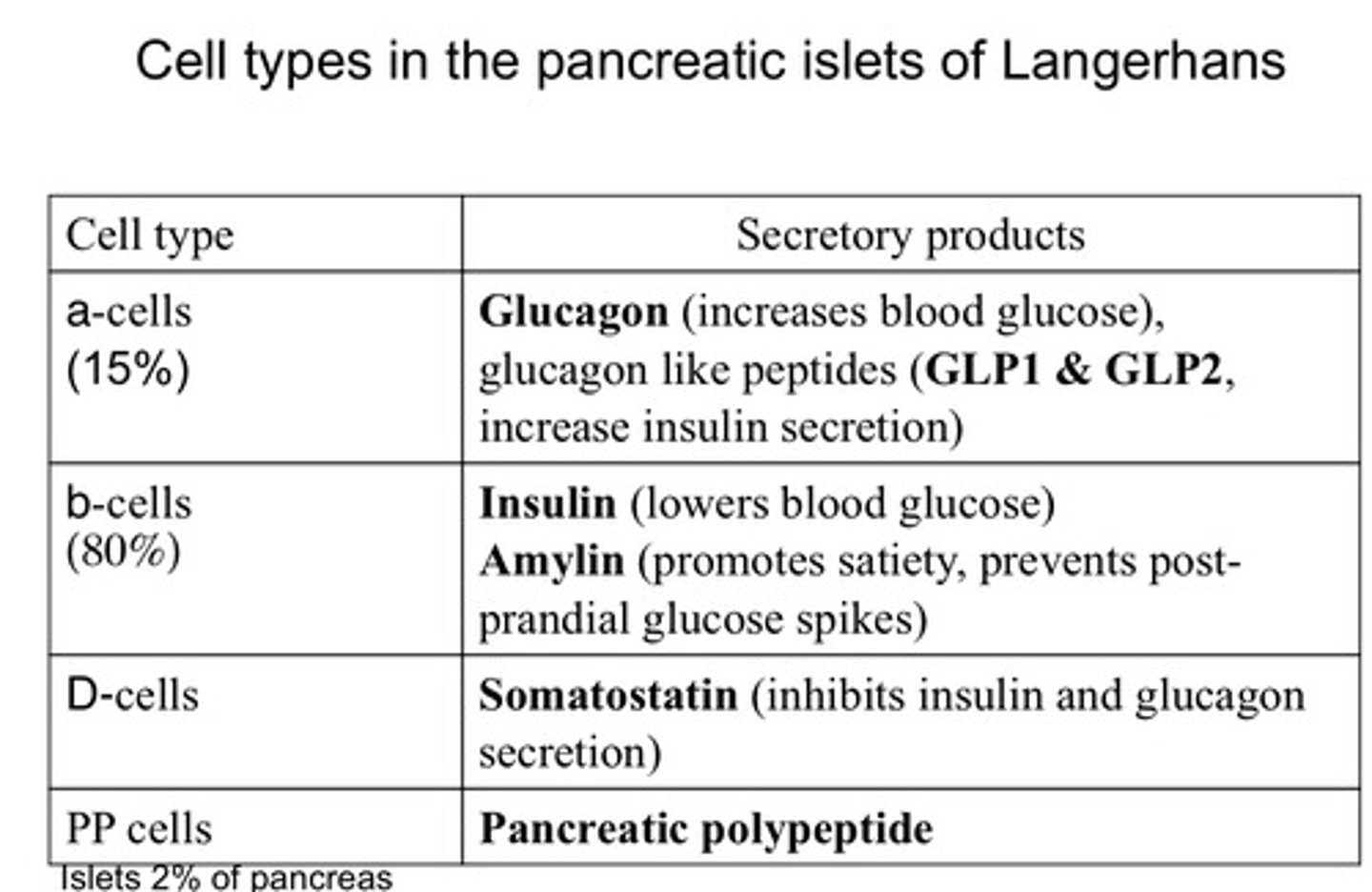
How are Incretins and Glucagons made in the body?
-Glucagons and incretins are made from the same pre-cursor
- Posttranslational processing of preproglucagon
- The preproglucagon gene encodes proglucagon, a peptide that is differentially
processed based on the relative activities of the prohormone convertases 1/3
and 2. In the α-cells of the pancreatic islet, prohormone convertase 2 (Psck2 - peptidase that cuts the precursor)
predominates and glucagon, glicentin-related pancreatic polypeptide (GRPP),
intervening peptide 1 (IP1), and a proglucagon fragment are the more
prevalent products.
- In the intestinal L-cell and specific CNS neurons, prohormone convertase 1
(Psck1) action is relatively greater and proglucagon is cleaved to GLP-1,
GLP-2, oxyntomodulin, glicentin, and IP2.
- Most recent evidence indicates that α-cells have some Prohormone Convertase 1/3 activity, and it
is likely that neurons and L-cells also have Prohormone Convertase 2.
What are incretin mimetics (drug), what is a weakness of it and suggest a solution?
- Act on GLP-1 receptor
- stimulate insulin release
- suppress glucagon
- reduce appetite and weight
- slow gastric emptying
- stimulate beta cell proliferation
Weakness: It is very unstable - rapidly cleaved by DPP4 is part of the reason for this
Solution: Structural changes of amino acids in GLP-1 analogues cause peptide to be
more stable and useful
Example: Exendin-4 isolated from saliva of Glia monster and then Exenatide was
formulated as the synthetic version
What are DPP-4 inhibitors?
- DPP-4 rapidly degrade incretins within minutes
- DPP4- inhibitors block this degradation
- no effect on weight and no hypoglycaemia
- Possible SE: increase in incidence of some cancers
Examples: Sitagliptin and Linagliptin
What are SGLT-2 inhibitors?
- Glucose reabsorbed in SGLT-2 and SGLT-1 in distal/proximal tubules
- Ideally want a drug that is better at inhibiting SGLT-2 than SGLT-1 (as more
reabsorbed at SGLT-2 receptor)
- Inhibits SGLT-2 so glucose not reabsorbed
Example: Dapagliflozin and Canagliflozin
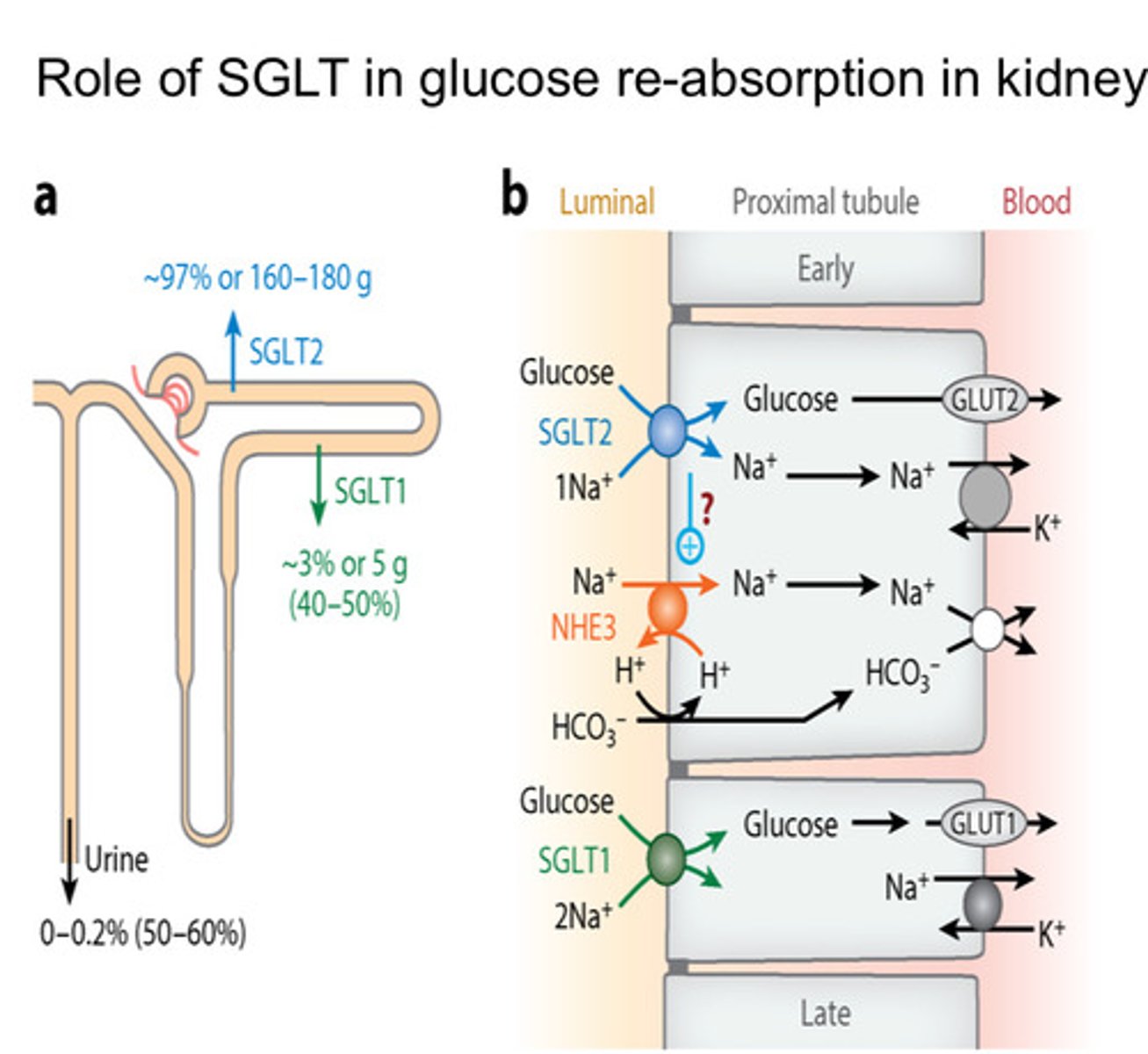
How do sulphonylureas work?
- hypoglycaemic agent - acutely increase insulin release, increase plasma insulin concentration
and decrease hepatic insulin clearance
MOA:
- inhibitor binds to sulphonylurea receptor and closes ATP-K channel = depolarisation
= insulin secretion
- receptor can be desensitised in chronic use
- largely protein bound increased interactions with NSAIDs/MAOIs/anitbiotics
-This happens regardless of having high or low glucose
- Excreted in urine with enhanced effect in elderly and renal impairment
- Main adverse effect is hypoglycaemia but also causes neuroglycopenia (lack
of glucose supply to top part of brain), confusion/coma ->solution is to take
oral glucose
- If severe give: IV glucose, glucagon, adrenaline
Examples:
1st generation:
Carbutamide and tolbutamide
2nd generation Glizlazide, Glimepiride and Gliplizide
What are the effects of chronic exposure of sulphonylureas to patients
Chronic exposure to this drug effects:
o No acute increase in insulin release BUT a decreased plasma glucose
concentration still remains
o Chronic hyperglycaemia as it decreases insulin release
o Down-regulation of sulphonylurea receptor
o Largely protein bound ~90-99% increases likelihood of drug
interactions with NSAIDS, MAOIs, some antibiotics
o Receptor desensitisation in chronic use
How is the MOA of sulphonylureas and ATP generation similar?
Inhibitors have same effect as ATP generation- bind to a site of
sulphonylureas receptor and close ATP-sensitive K channel = depolarises
eventually secretes insulin
- When glucose is taken up by the cell it goes into mitochondria where it is
oxidised and ATP is generated
- ATP closes an ATP-sensitive K channel which has sulphonylureas as a co-
factor
- When ATP closes channel = depolarises beta cell = opens calcium channel =
calcium ion influx = stimulates exocytosis of secretory granules = insulin
secreted out from beta cells
How do meglitinides work? compare them to sulphonylureas
- close ATP-K channel on beta cells (Same MOA as sulphonylureas )
-share two binding sites
with sulphonylureas but have their own distinct binding site
- more selective for beta cells than cardiac ATP-K
- more rapid, less sustained release than sulphonylureas
- less potent than sulphonylureas
- Cause less hypoglycaemia
-Taken before a meal
How do Thiazolidinediones (glitazones) work?
- selective agonists for PPAR-gamma (a transcription factor) in adipose, muscle and liver
-PPAR-gamma Dimerises with RXR (retinoid X receptor)
MOA :
- Thiazolidinediones activate insulin responsive genes that control carbohydrate and lipid metabolism; they need insulin to be effective
- reduce insulin resistance in peripheral tissues
- reduce liver glucose production
-Enhances actions of insulin
- increase glucose uptake in muscle/adipose
- increase adipocytes and lipogenesis
- weight gain - due to increased differentiation of adipocytes, fluid retention by stimulating amiloride sensitive Na-absorption
Example : Pioglitazone
Extra info:
-Half-life of 7 hours and takes 6-12 weeks for maximum effects
-Given with metformin, insulin or other hypoglycaemic drugs
What are the effects of PPAR-gamma activation?
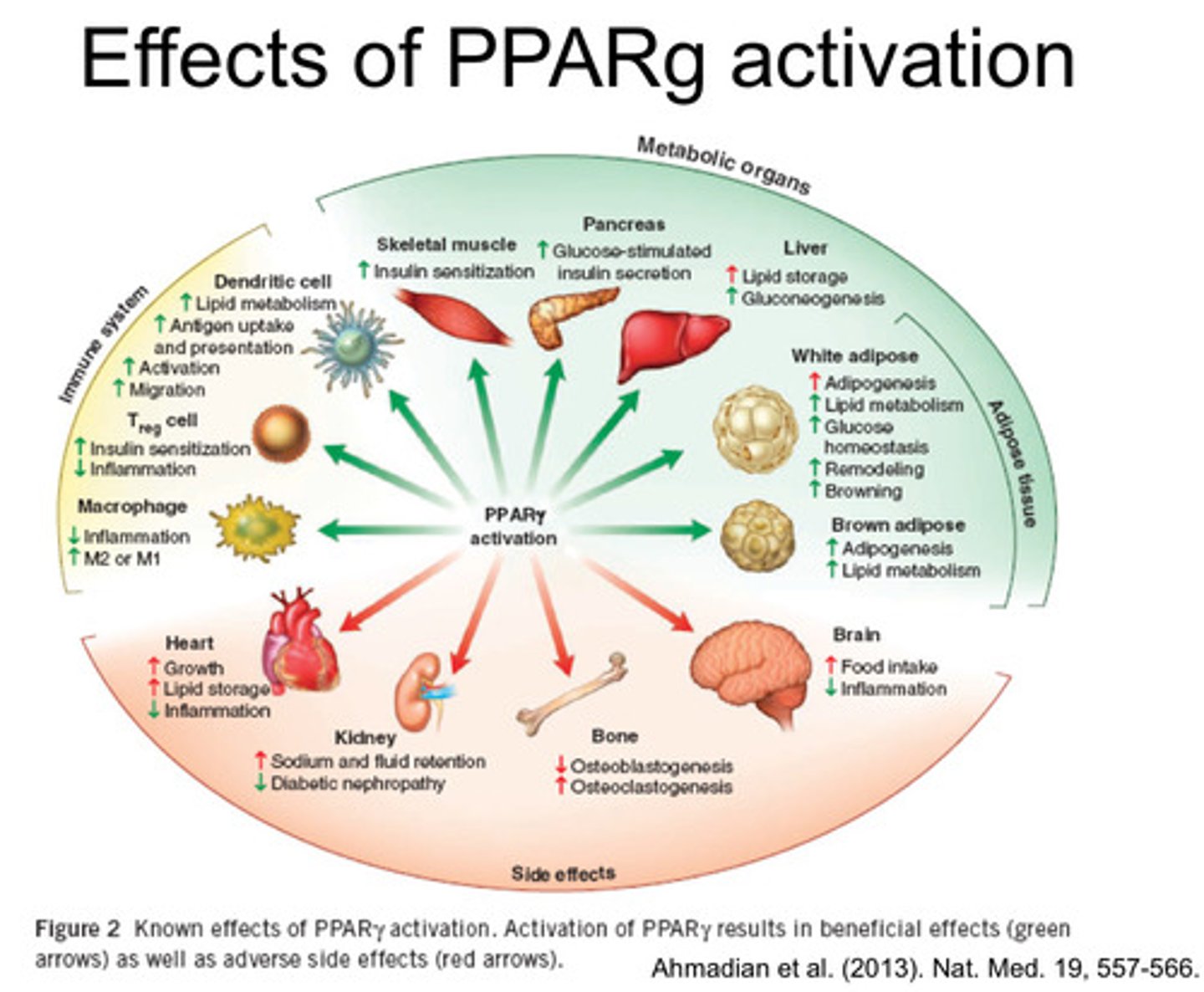
How do a-GLUCOSIDASE INHIBITORS (AGIs) work
•AGIs inhibit the absorption of carbohydrates from the small intestine
•Inhibit enzymes that convert complex non-absorbable carbohydrates into absorbable ones (effective in Type I and Type 2).
•Reduce postprandial hyperglycaemia.
Side effects
flatulence and diarrhoea
How do AMYLIN ANALOGUES work
-Amylin (37aa) main component of pancreatic amyloid
related to calcitonin/CGRP:
- Decreases gastric emptying
Inhibits glucagon release
-Promotes satiety, decreases food intake
-Related to b-amyloid, which forms aggregates in neurodegenerative diseases
Example: Pramlintide - analogue of human amylin with Pro replacement as in rat amylin - does not aggregate
-Can be used in both TYPE I and II
INSULIN
-See insulin quizlet
Decision cycle for management of Type 2 diabetes
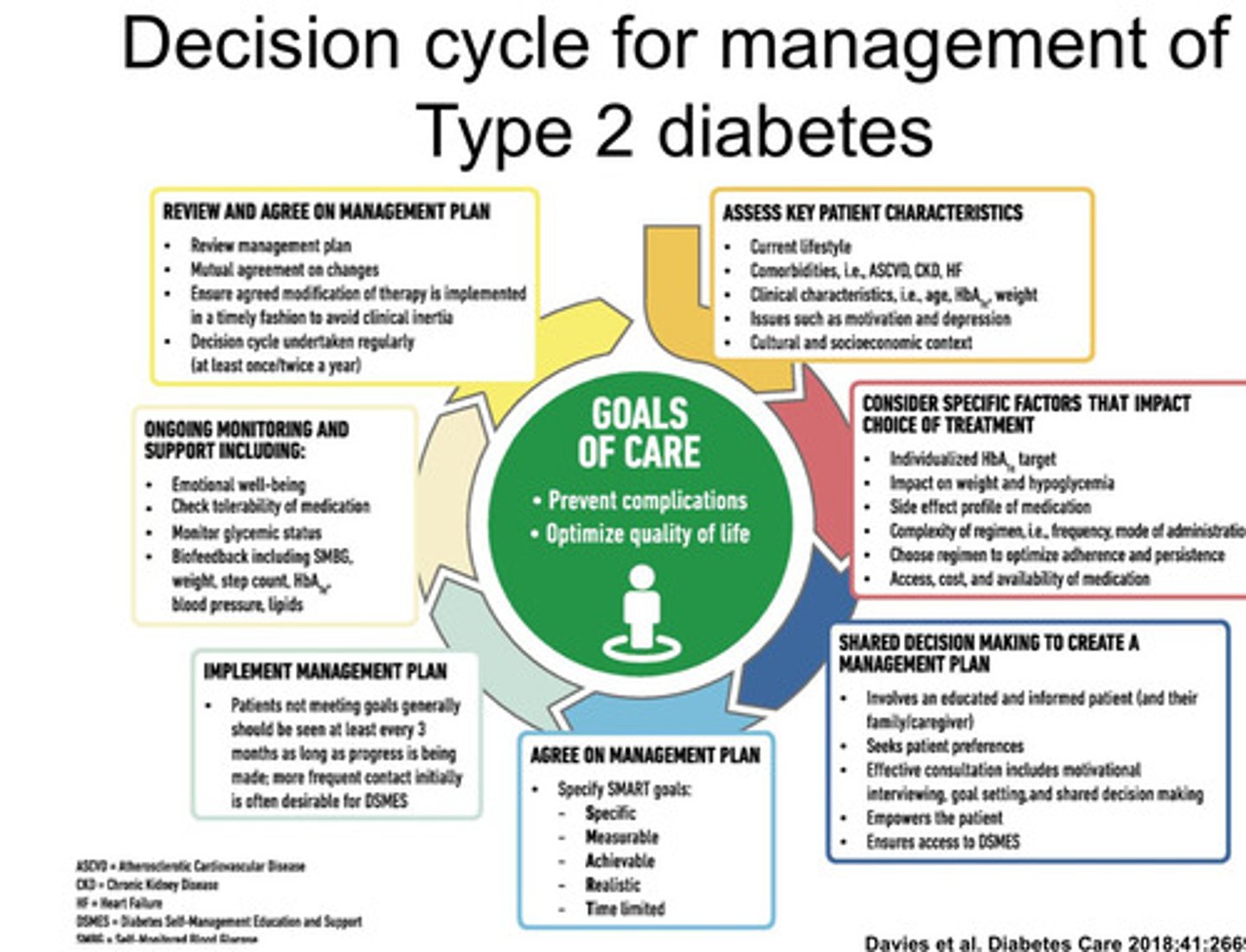
What are the agents for obesity?
- lipase inhibitor e.g. Orlistat
- GLP-1 agonist e.g. Buproprione, Naltrexone, Saxenda
-5HT-2C agonist e.g., Lorcaserin